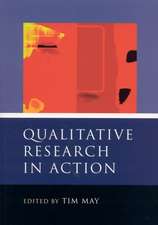Network Analysis Literacy: A Practical Approach to the Analysis of Networks: Lecture Notes in Social Networks
Autor Katharina A. Zweigen Limba Engleză Hardback – 27 oct 2016
| Toate formatele și edițiile | Preț | Express |
|---|---|---|
| Paperback (1) | 842.70 lei 38-45 zile | |
| SPRINGER VIENNA – 22 apr 2018 | 842.70 lei 38-45 zile | |
| Hardback (1) | 917.05 lei 3-5 săpt. | |
| SPRINGER VIENNA – 27 oct 2016 | 917.05 lei 3-5 săpt. |
Din seria Lecture Notes in Social Networks
- 20%
 Preț: 655.35 lei
Preț: 655.35 lei - 20%
 Preț: 990.80 lei
Preț: 990.80 lei - 18%
 Preț: 1003.38 lei
Preț: 1003.38 lei - 20%
 Preț: 337.52 lei
Preț: 337.52 lei - 20%
 Preț: 649.28 lei
Preț: 649.28 lei - 20%
 Preț: 996.07 lei
Preț: 996.07 lei - 15%
 Preț: 503.83 lei
Preț: 503.83 lei - 18%
 Preț: 998.66 lei
Preț: 998.66 lei - 18%
 Preț: 728.74 lei
Preț: 728.74 lei - 20%
 Preț: 991.60 lei
Preț: 991.60 lei - 18%
 Preț: 1106.00 lei
Preț: 1106.00 lei - 20%
 Preț: 668.58 lei
Preț: 668.58 lei - 5%
 Preț: 349.68 lei
Preț: 349.68 lei - 20%
 Preț: 339.14 lei
Preț: 339.14 lei - 20%
 Preț: 587.60 lei
Preț: 587.60 lei - 15%
 Preț: 644.82 lei
Preț: 644.82 lei - 20%
 Preț: 628.55 lei
Preț: 628.55 lei - 15%
 Preț: 587.72 lei
Preț: 587.72 lei - 20%
 Preț: 648.44 lei
Preț: 648.44 lei - 20%
 Preț: 570.97 lei
Preț: 570.97 lei - 20%
 Preț: 642.52 lei
Preț: 642.52 lei - 20%
 Preț: 655.02 lei
Preț: 655.02 lei - 15%
 Preț: 643.34 lei
Preț: 643.34 lei - 20%
 Preț: 764.43 lei
Preț: 764.43 lei - 20%
 Preț: 649.93 lei
Preț: 649.93 lei - 20%
 Preț: 649.60 lei
Preț: 649.60 lei - 20%
 Preț: 650.08 lei
Preț: 650.08 lei - 20%
 Preț: 889.64 lei
Preț: 889.64 lei -
 Preț: 389.11 lei
Preț: 389.11 lei -
 Preț: 395.09 lei
Preț: 395.09 lei - 20%
 Preț: 649.75 lei
Preț: 649.75 lei - 20%
 Preț: 924.56 lei
Preț: 924.56 lei - 20%
 Preț: 341.95 lei
Preț: 341.95 lei - 20%
 Preț: 992.76 lei
Preț: 992.76 lei - 20%
 Preț: 934.03 lei
Preț: 934.03 lei - 15%
 Preț: 641.03 lei
Preț: 641.03 lei
Preț: 917.05 lei
Preț vechi: 1118.36 lei
-18% Nou
Puncte Express: 1376
Preț estimativ în valută:
175.48€ • 187.65$ • 146.31£
175.48€ • 187.65$ • 146.31£
Carte disponibilă
Livrare economică 28 martie-11 aprilie
Preluare comenzi: 021 569.72.76
Specificații
ISBN-13: 9783709107409
ISBN-10: 3709107407
Pagini: 400
Ilustrații: XXIII, 535 p. 126 illus., 14 illus. in color.
Dimensiuni: 155 x 235 x 34 mm
Greutate: 1.19 kg
Ediția:1st ed. 2016
Editura: SPRINGER VIENNA
Colecția Springer
Seria Lecture Notes in Social Networks
Locul publicării:Vienna, Austria
ISBN-10: 3709107407
Pagini: 400
Ilustrații: XXIII, 535 p. 126 illus., 14 illus. in color.
Dimensiuni: 155 x 235 x 34 mm
Greutate: 1.19 kg
Ediția:1st ed. 2016
Editura: SPRINGER VIENNA
Colecția Springer
Seria Lecture Notes in Social Networks
Locul publicării:Vienna, Austria
Public țintă
ResearchCuprins
Dedication.- Preface.- Part I Introduction.- A First Encounter.- Graph Theory, Social Network Analysis, and Network Science.- Definitions.- Part II Methods.- Classic Network Analytic Measures.- Network Representations of Complex Systems.- Random Graphs and Network Models.- Random Graphs as Null Models.- Understanding and Designing Network Measures.- Centrality Indices.- Part III Literacy.- Literacy: Data Quality, Entities and Nodes.- Literacy: Relationships and Relations.- Literacy: When is a Network Model Explanatory?.- Literacy: Choosing the Best Null Model.- Literacy Interpretation.- Ethics in Network Analysis.- Appendix A - The structure and typical outlets of network analytic papers.- Appendix B - Glossary.- Appendix C - Solutions to the Problems.- Name Index.- Subject Index.
Recenzii
“The book is a good source for researchers, network experts, and scientists studying network analytics. … It can also be used as a textbook in graduate classes. There are exercises and further reading sections at the end of each chapter, which will be useful to instructors. The book will also help readers understand how to think in a network analytics discipline.” (Gulustan Dogan, Computing Reviews, February, 2018)
Notă biografică
Katharina A. Zweig has studied biochemistry and bioinformatics at the University Tübingen, Germany (1996-2006). In her doctoral studies, she was concerned with the relation of local structure and global behavior in the evolution of complex networks (2007, University Tübingen, Germany). Her postdoc was done in statistical physics at ELTE University, Hungary (2008-09); after that she lead an independent junior research group at University Heidelberg, Germany (2009-2012). Since 2012, she is a professor for „Graph Theory and Complex Network Analysis“ at TU Kaiserslautern, Germany. She is a Junior Fellow of the German Society of Computer Science and was elected as one of 39 Digital Thinkers („Digitale Köpfe“) in 2014 in Germany. Since she started to work on the use of centrality indices in network analysis in 2003, network analysis literacy has been her main concern. Currently, her research is focused on the more general question of how to make algorithms accountable, i.e., how to make surethat an algorithm’s numerical answer matches the intuition behind the problem modeled by it. In 2016, she co-founded Algorithm Watch, a non-profit organisation to hold algorithms accountable and to consult society, politics, industry and public institutions about all questions concerning algorithm accountability.
Textul de pe ultima copertă
This book presents a perspective of network analysis as a tool to find and quantify significant structures in the interaction patterns between different types of entities. Moreover, network analysis provides the basic means to relate these structures to properties of the entities. It has proven itself to be useful for the analysis of biological and social networks, but also for networks describing complex systems in economy, psychology, geography, and various other fields. Today, network analysis packages in the open-source platform R and other open-source software projects enable scientists from all fields to quickly apply network analytic methods to their data sets. Altogether, these applications offer such a wealth of network analytic methods that it can be overwhelming for someone just entering this field. This book provides a road map through this jungle of network analytic methods, offers advice on how to pick the best method for agiven network analytic project, and how to avoid common pitfalls. It introduces the methods which are most often used to analyze complex networks, e.g., different global network measures, types of random graph models, centrality indices, and networks motifs. In addition to introducing these methods, the central focus is on network analysis literacy – the competence to decide when to use which of these methods for which type of question. Furthermore, the book intends to increase the reader's competence to read original literature on network analysis by providing a glossary and intensive translation of formal notation and mathematical symbols in everyday speech. Different aspects of network analysis literacy – understanding formal definitions, programming tasks, or the analysis of structural measures and their interpretation – are deepened in various exercises with provided solutions. This text is an excellent, if not the best starting point for all scientists who want to harness the power of network analysis for their field of expertise.
Caracteristici
Teaches how to pose a defined network analytic question Demonstrates how to design the best model for describing a given graph Aids in choosing or designing the best random graph model for comparing analytical results Helps to interpret network analytic results Discusses ethical questions regarding network analysis Contains exercises and programming problems Includes supplementary material: sn.pub/extras















